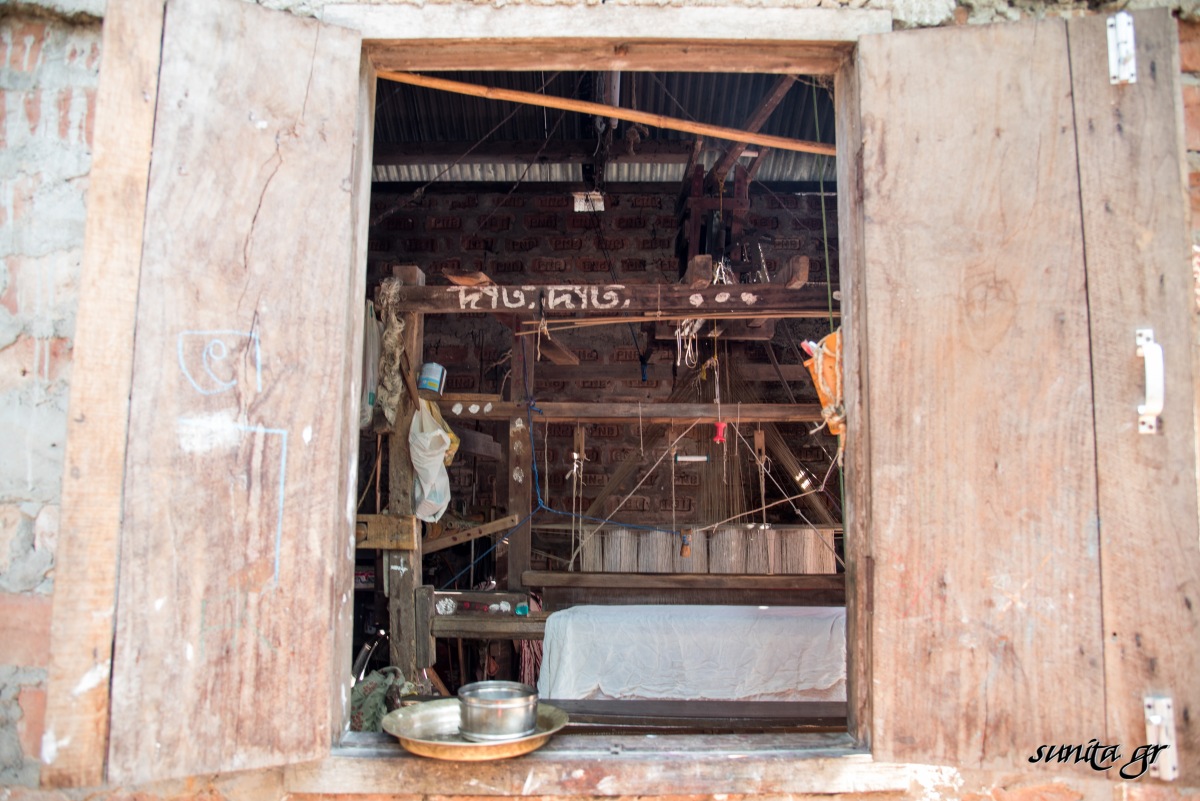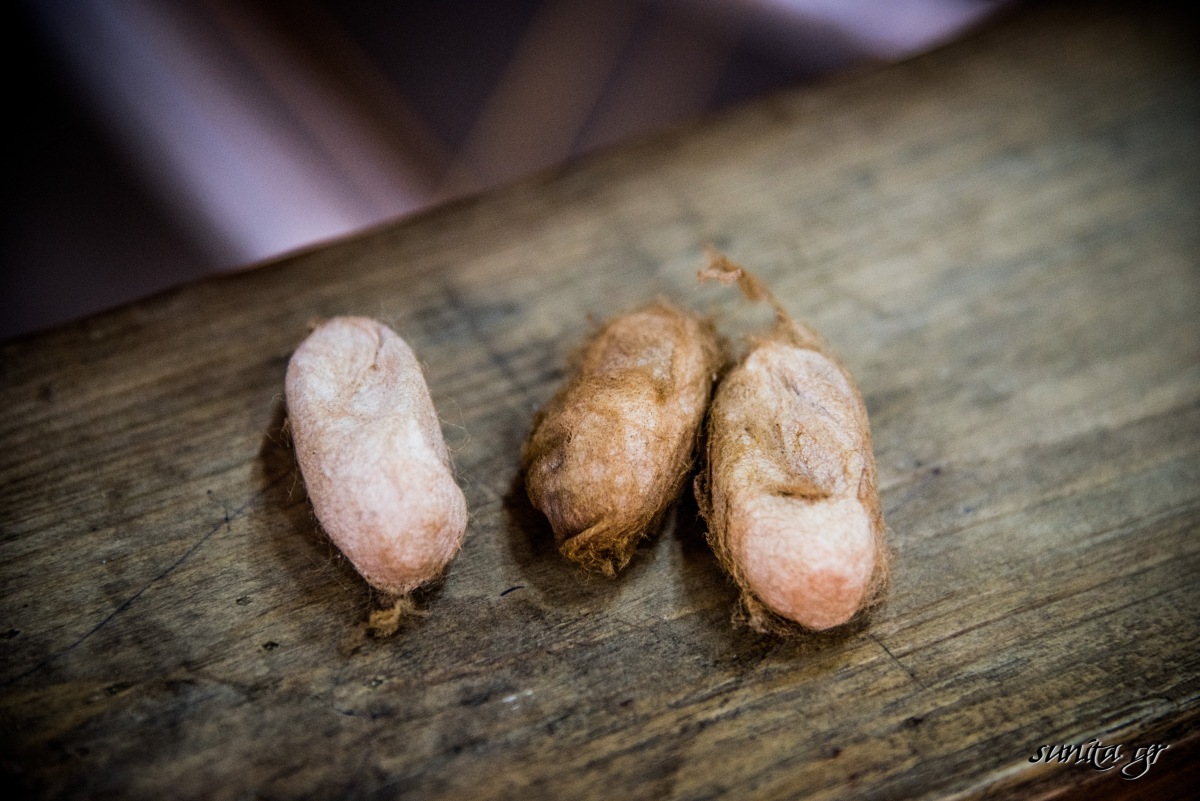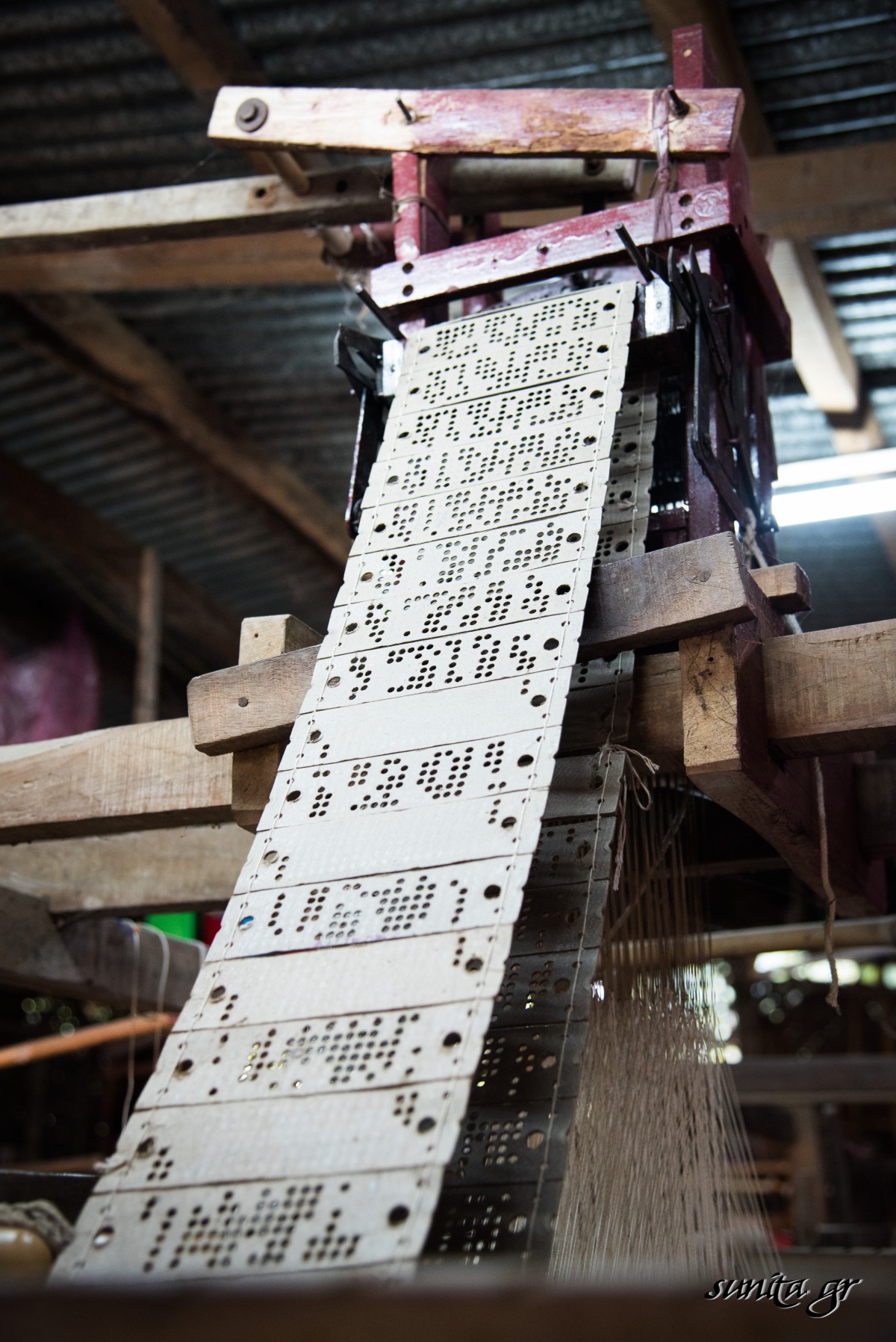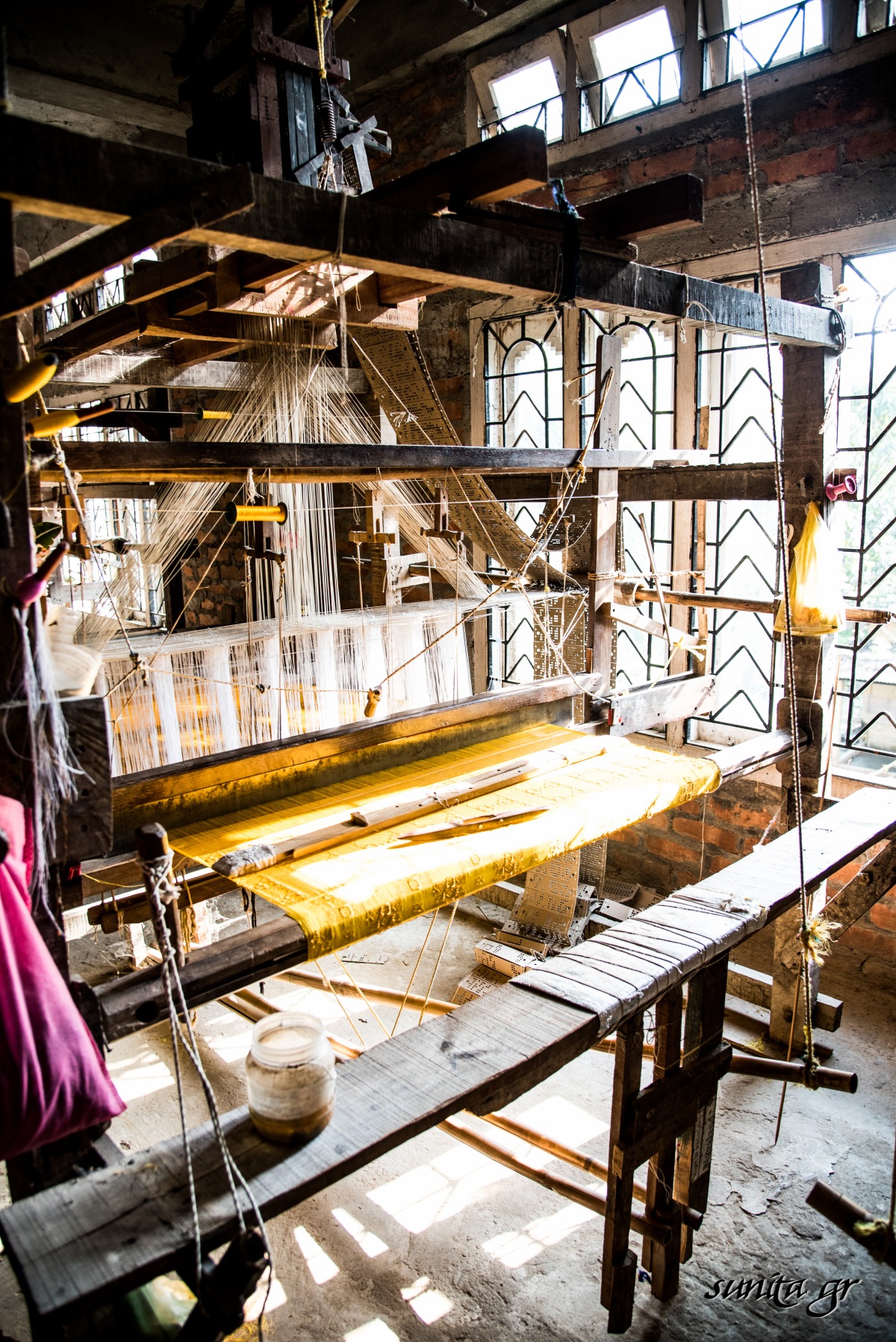“Hum sab workers ne protest kiya. Hum Varanasi se cheap powerloom products yahan aane nahi de sakte tey. 2-3 log bhuri tarah ghayal hog aye use protest mein (We all weavers organised a protest. We couldn’t let the powerloom products from places like Varanasi enter this village. 2-3 people were injured badly in the fighting that erupted during the protest),” said Tapan, a supervisor of handloom silk factory employing 20 workers in Sualkuchi.
Sualkuchi (pronounced as Hualkusi), popularly known as the Manchester of the East, is a small village 35 kms from Guwahati where the primary occupation of the villagers is silk weaving of the famous and fine Assam Silk. Assam is famous for Muga, Pat & Eri Silk of which the Muga silk is the only one exclusive to Assam as silkworm from which it is made is endemic to Assam. It is naturally golden in colour and the colour only becomes more bright and golden with every wash. Pat silk also known as Mulberry silk, is pearly white and is made from mulberry silkworms. Eri silk is also known as the Ahimsa silk as the silk threads are made from the cocoons after the adults have left it and hence the pupae are not killed in the harvesting process unlike what happens in the harvesting of other varieties of silk.
The silk handloom tradition in Sualkuchi dates back to 11th century when the Pal dynasty king established the village by bringing in silk weaving families from Tantikuchi and settled them here. The tradition continued over generations, firmly entrenching Sualkuchi by 17th century as the silk weaving centre of Assam, producing fine Mekhela Chadars, Gamosas (both are traditional Assamese garments worn by women & men respectively) & Sarees. As I walked through the back-lanes of the village, through open doors and windows, I could see almost every household having 2-3 looms. I visited some medium scale ‘factories’, either with 30- 40 looms operating from a whole floor of a 2 storeyed run-down house or with 20-30 looms in an improvised cowshed behind the residential huts. It is estimated that in a population of 14000, the village has about 17000 looms which well indicates the prominence and importance of weaving in every villager’s life.
No wonder the battle between handloom and powerloom is a battle for survival of this traditional craft. Mechanising the industry with powerloom reduces the cost of labour & hence lowers the cost of the final silk weaves. Few years ago, the market was besieged with powerloom products from Varanasi which often used cheaper silk, i.e. silk mixed with polyester which reduced the prices further. Since it is difficult for a consumer to tell the difference between powerloom and a handloom weave and equally difficult to tell the difference between 100% silk and adulterated silk, the costs charged by the local handlooms comes under a big question and puts further pressure on the viability of the handloom factories. “Powerloom iss village mein aane hi nahi de sakte (We cannot let powerloom enter this village),” passionately cries Tapan.
The angst is well justified. I could only understand it better when I walked into a shop. As my jaw dropped after hearing the prices of sarees (a pure silk saree costs upwards of Rs.5.5-6K), the shop manager, Arun, visibly upset with the look on my face said, “Aap mere saath aayiye madam. Main aapko dikhata hoon. Aap phir samjhenge iski saree ki keemat (You come with me madam. I will show you. Only then you will appreciate the worth of this saree).” As I walked into a rundown factory, I was indeed appalled. The conditions in which the weavers work is frightening and saddening. Most factories are set up in jute and bamboo sheds, much like an improvised cowshed! The factories are cramped to pack in as many looms as possible, fitting in as many as 30 looms in a 600sqft area. There is little sunlight and no fans to keep them cool on a hot summer day. The process of silk weaving is time consuming and labour intensive. Depending on the design, it could easily take 6-7 days with 12-14 hours of non stop work with only lunch breaks in between to weave a full saree. There are no fixed hours of work and no weekends off either. Only in the context of seeing the working conditions and knowing about the tedious process, was I able to appreciate the “worth” of the silk weave and the angst the weaver community had towards onslaught of cheaper and inferior powerloom products.
Equally, skilled labour is also increasingly hard to come by. “Wapas aayenge ki nahi pata nahi (I don’t know whether they will come back or not),” laments Arun who is also supervisor of the handloom factory apart from being the shop manager. Since there is a state election the next day, he has given an off to the workers to go back to their villages to cast their vote. That is the sad reality. While lot of government effort has gone into making it a co-operative industry, it still remains highly unorganized. Many villagers have given up the traditional craft to pursue more lucrative opportunities in cities. Hence most of the weavers are migrants who come in from other parts of the country to work & earn here. But there is no system to check, verify and track the workers, making it difficult for factory owners to get reliable labour.
The rocketing raw material prices have further put pressure on the industry here. The process of cultivating silkworms, harvesting and creating the threads have been mostly outsourced while some local operations still exist. The pat silk threads usually come in from Bangalore and the supplies have shrunk, spiralling the prices upwards. Coupled with the flooding of the market with ‘semi silk’, which is nothing but synthetic silk made with polyester with a look & finesse of real silk and at almost 1/5th the price of real silk, the viability of the handloom industry is really challenged.
Despite all the issues plaguing the industry, it refuses to die. The demand for Assam silk is very high and Sualkuchi contributes to ~75% of the Assam’s output. It is the hub for wedding shopping as prices here can be easily lower by 1500-2000 rupees and in an Indian wedding where clothing is gifted to close relatives from both bride and groom side, buying in bulk does mean lots of savings! Demand is also coming in from international buyers from Thailand, Germany etc. who buy in bulk and sometimes also give their own designs for production. Several government initiatives are helping the handloom owners after their plight has been highlighted by media and in other forums. For e.g. Govt has set up a fashion institute in collaboration with NIFT which imparts training for skill up-gradation, design process & innovation, apart from widening their perspective on fashion and trends, so that they can cater to demand in a fast changing fashion environment. Traditionally, the design pattern for the borders and the motifs embellishing the saree are first sketched and then holes are manually punched on paper cards. These reams of design cards are mounted on the loom and the weaving happens as per the patterns on these cards. Now with the help of the institute, design process and the punching is now being increasingly computerized, saving lot of time and manual effort.
Tapan speaks about his future, “Experience mil gaya hai mujhe. Ab apna chota factory open karoonga (Now I have the experience. I want to open a small factory of my own).” As Tapan continues to talk about his dreams, his young 8 yr old son, Shyam, walks in to eagerly show us more about the factory where his dad works. “Ji haan. Usse sab aata hai. Roz yeh sab dekh raha hai jab se bacha tha (Of course! He knows how to weave. He has been seeing all this everyday since he was a child),” says Tapan upon being asked whether Shyam knows how to weave as well. Will Shyam continue in his father’s footsteps, I ask eagerly. “Bas padh likh kar achi naukri kare city mein, main toh yeh hi chahoonga (I only wish that he studies well and gets a good job in the city),” he says with a dreamy voice. The dreams are indeed silken.
————————————————————————-
How to reach Sualkuchi
It is 35kms from Guwahati, about an hour’s drive. Stay in Guwahati.
Visit the place before noon. Weavers have lunch breaks from 1-3pm.
————————————————————————–












Great Post
LikeLike
thanks mukul. have you been to north east? the sheer number of plants i saw there reminded me of your blog 🙂
LikeLiked by 2 people
yes have been , but was not blessed with the vision to see nature then.
LikeLike
haha 🙂 it happens.:) when i look at my pictures now from older travels, it sucks! i feel i should go back and see the place again.
LikeLiked by 1 person
though sometimes i admire older pics too thinking did I take these lovely shots?
LikeLiked by 1 person
Love your photos – thanks for sharing!
LikeLike
thank you!
LikeLike
Good silk in sualkuchi
LikeLike